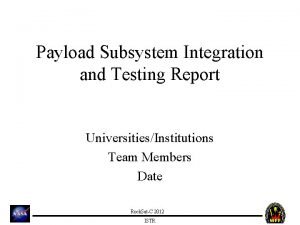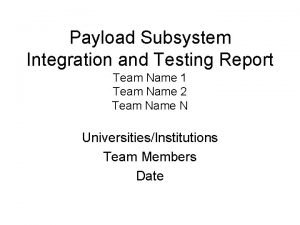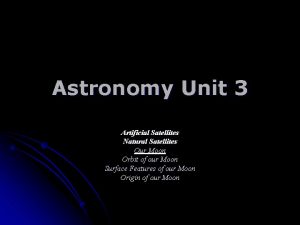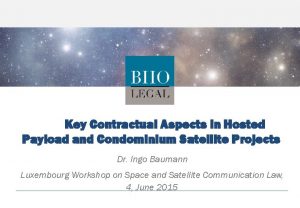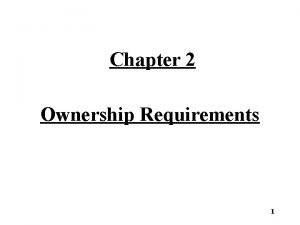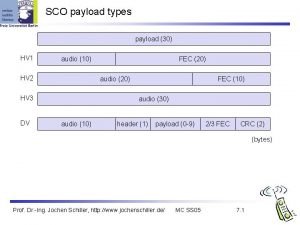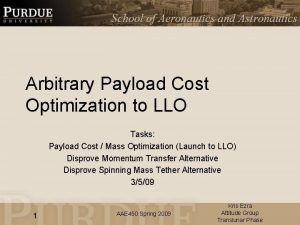Models of Ownership Condominium and hosted payload satellites













- Slides: 13

“Models of Ownership: Condominium and hosted payload satellites” Gerry Oberst Senior Vice President, Global Regulatory & Governmental Strategy 4 June 2015 4 th Luxembourg Workshop on Space and Satellite Communication Law -- Ownership of Satellites

Models of Ownership: Condominium and hosted payload satellites Introduction Satellite ownership can raise substantial regulatory and international law issues, beyond the contractual and business issues Normal ownership arrangements involve a single company or joint venture owning a specific satellite that provides service under license from a specific country We have seen expanded use, however, of an ownership arrangement called a “condominium satellite” or “condosat” that extends beyond the “normal” arrangement, but there is relatively little in the way of commentary or analysis on this approach This presentation defines what condosats are, notes how and why they have developed, and distinguishes hosted payloads, which sometimes are lumped in with condosats Along the way we identify how ownership models implicate issues to be discussed further in other presentations in this workshop 4 th Luxembourg Workshop on Space and Satellite Communication Law -- Ownership of Satellites 2

Models of Ownership: Condominium and hosted payload satellites Definitions derive both from ownership of the satellite infrastructure and the frequencies / orbital slots used: • Condominium usually means more than one owner of the satellite infrastructure – two or more separate companies owning discrete parts or rights to part of the satellite • The same term also has been applied (less often) to situations where the multiple owners use satellite frequencies under rights by more than one country • This can be distinguished from another common practice of a single owner using satellite frequencies under rights by more than one country (the recent Intelsat EPIC satellite example) 4 th Luxembourg Workshop on Space and Satellite Communication Law -- Ownership of Satellites “A Condo. Sat is similar [to real estate condominiums] in that the owners share the bus, the power system, the reflectors, and possibly even the waveguide and TWTAs, but there is agreement that each party has access to certain shares of the satellite capacity in certain geographic regions. ” S. Gardner, 2014 3

Models of Ownership: Condominium and hosted payload satellites “Condosat” is a term used in the industry that has shifted in meaning • Earliest usage found in the U. S. was in the early 1980 s, for a proposed ownership model involving sale or lease of transponders designed to avoid being limited by then-existing international satellite agreements (e. g. , Orion Satellite Corp’s initial application to operate private, user-owned satellite despite the INTELSAT agreement) • This term became unnecessary when FCC allowed satellite services to compete with INTELSAT for non-PTSN lines; this change in approach was called the “separate satellite policy” – i. e. , separate from the intergovernmental INTELSAT system, and ownership was not the main factor on which the FCC authorization hinged • Subsequently, the model of leasing transponders became the norm – but this model has rarely been characterized as a condominium arrangement {contra 1986 study for NASA, which probably was based on the early model} 4 th Luxembourg Workshop on Space and Satellite Communication Law -- Ownership of Satellites 4

Models of Ownership: Condominium and hosted payload satellites Joint ownership (i. e. , “condo” ownership) has taken off within the commercial satellite communications field. Reasons can be diverse: • Sharing of risks – especially in the Asian market, with a prime example of ABS “Condosat” • Market entry – sharing ownership with a local in order to obtain national authorizations (not entirely consistent with trade agreement principles but a real life issue) • National satellite capacity – a country may seek a national system but cannot justify the cost of an entire satellite and thus shares with another operator • Frequency management – when the operator seeks to rely on more than one national filing and for various reasons relies on diverse ownership 4 th Luxembourg Workshop on Space and Satellite Communication Law -- Ownership of Satellites “Asia-Pacific satellite operators see partnerships via shared satellites as the main way forward to expand their businesses and gain operational efficiencies as national politics prevents badly needed consolidation in the region. Several regional satellite operators CEPs cited cooperation and the rise of socalled “condo-sats’ (sic) … as the key development in the Asian satellite market…” Telecom Asia, June 2012 5

Models of Ownership: Condominium and hosted payload satellites Hosted payloads, although sometimes lumped in with condominium arrangements, are another category of ownership / operation: • Some have discussed hosted payloads as if they were a form of condosat (e. g. , A. Tadros, “The Business of Hosted Payloads, AIAA Sept. 2010) • The two are not the same, however, and a distinction arises in the nature of the mission and ownership arrangements: hosted payloads generally leverage space on a satellite to host a secondary mission, i. e. , an instrument, application or “strap on” device not owned by the underlying satellite operator “The hosted payload concept is not new or uncommon: … the first U. S. government hosted payload flew on a commercial satellite nearly four decades ago. ” SIA, November 2014 “Hosted Payload (HP) refers to a payload housed on a satellite for which it is not the primary payload, nor owned by the primary operator. Either a commercial or government/military satellite can be the host. As such, the HP operator rents “real estate” on a satellite (mass, power, volume…) and owns only its payload. It does not have any ownership over the satellite itself. This concept differs from that of a Condosat, which NSR defines as a combined procurement approach to a satellite that is owned jointly by two or more operators. In a Condosat arrangement, the ownership of the satellite is shared between two (potentially more) organizations; this shared ownership extends beyond the payload to the common systems (platform). ” Northern Sky Research (NSR) 2014 4 th Luxembourg Workshop on Space and Satellite Communication Law -- Ownership of Satellites 6

Models of Ownership: Condominium and hosted payload satellites Hosted payloads, distinctions from condosats (cont’d): • Examples abound – U. S. Federal Aviation Administration Wide-area augmentation system (WAAS); NASA Global-scale Observations of the Limb and Disk {not a Terry Pratchett story…} • Hosted Payload Alliance lists 29 major examples as of March 2014, including substantial efforts such as European GPS Navigation Overlay System (EGNOS) • Important to make the distinction as the hosted payload owner typically has no ownership interest in the primary infrastructure, i. e. , neither the main bus or the payload, and hence typically has no operational control over the satellite • Taking the real estate metaphor, a hosted payload is the right to use the swimming pool in a shared building, and maybe only for a few months, but not to own and occupy entire apartments “Established in 2011, The Hosted Payload Alliance (HPA) is a satellite industry alliance whose purpose is to increase awareness of the benefits of hosted government payloads on commercial satellites. The HPA seeks to bring together government and industry in an open dialogue to identify and promote the benefits of hosted payloads. ” http: //www. hostedpayloadalliance. org/About-Us. aspx; see also “case studies” 4 th Luxembourg Workshop on Space and Satellite Communication Law -- Ownership of Satellites 7

Models of Ownership: Condominium and hosted payload satellites What issues can arise? (first of two slides) “This sharing of ownership makes decision-making a potentially tricky process; it calls for the two organizations to have similar drivers (both commercial organizations for example). ” NSR 2014 • Procurement issues – timing, technology issues, insurance, third party liability – these are contract considerations to be hammered out in preliminary negotiations • A major point is which of the two participants drives the procurement process and monitors the construction phase. Also determining access to the common parts of the satellite in case of anomalies/failures should be predetermined • Operational control – which party controls the spacecraft – contractually defined in great precision and important for national licensing and international liability - National pride in this context should not be underestimated • “Accommodation of Business Plans” – subsequent sales, insolvency considerations, satellite relocations – mainly dealt with contractually, but can be unanticipated 4 th Luxembourg Workshop on Space and Satellite Communication Law -- Ownership of Satellites 8

Models of Ownership: Condominium and hosted payload satellites What issues can arise? (second of two slides) “…space treaty arrangements as to rights and duties are framed in terms of the single integral ownership of a satellite. […] The relevant treaties therefore require amendment to provide for multiownership and for changes in the ownership of satellite in orbit. ” F. Lyall & P. Larsen, Space Law: A Treatise, pp 471 -72 (Ashgate 2009) • “Launching state” – an issue already complicated, made more complex if two or more parties of different nationalities are involved, hence involving more than one country in the procurement, launch and licensing / regulation of the satellite • Regulatory and national licensing – different regimes may apply different requirements which may overlap in a complimentary way or conflict (two separate owners with separate nationality may require duplicate licensing) Technology transfer and export issues – could make the design and operation of the satellite more complex • • Landing Rights – different payloads on parts of the same satellite can create complexities (country ‘A’ uses leverage over market entry authorization of satellite payload ‘A’ to exert changes or coordination agreement in satellite payload ‘B’ on same satellite but in different frequencies and dedicated to market entry in country ‘B’) 4 th Luxembourg Workshop on Space and Satellite Communication Law -- Ownership of Satellites 9

Models of Ownership: Condominium and hosted payload satellites What issues can arise? (the launching state complication) Condosat procured by nationals of countries A & B Condosat launched by nationals of country D (in country E? ) Condosat licensed to operate by countries B & C (at least some overlap!) Condosat registered by country ? ? Condosat sold in orbit to nationals of country F … The concept of the launching state already is complex, and will be made more complicated if there is multiple ownership of the satellite and, hence, of the launching state 4 th Luxembourg Workshop on Space and Satellite Communication Law -- Ownership of Satellites 10

Models of Ownership: Condominium and hosted payload satellites What issues can arise? (the landing rights / coordination complication) Condosat 1 licensed to operate by countries A & B C-band to country A Ku- / Ka-band to country B Ku- / Ka-band by competing satellite licensed to operate by country A The condosat arrangement can expose an operator to multiple regulatory requirements and give leverage for (onerous) coordination requirements In this example, Country A requires coordination compromises with respect to Ku- / Ka-band service to country B as the “price” of market entry for C-band service into country A 4 th Luxembourg Workshop on Space and Satellite Communication Law -- Ownership of Satellites 11

Models of Ownership: Condominium satellites Examples of geosynchronous condosats: Satellite Orbital slot Company Launch ST-1 and ST-2 88 E Sing. Tel / Chunghwa Telecom (Taiwan) 1998 and 2011 OPTUS C 1 156 E AUSSAT (Singtel) commercial and government payloads 2003 Horizon 1 and 2 127 W and 74 W Intelsat / Sky Perfect JSAT 2003 and 2007 IS-15 85 E Intelsat / Sky Perfect JSAT 2009 BSAT-3 c / JCSAT-110 R 110 E BSAT / Sky Perfect JSAT 2011 Bermudasat-1 / Echo. Star 6 96. 2 W SES Bermuda / Echostar 2013 Azersat 1 / Africasat-1 A 46 E Azercosmos, operating under Azerbaijan’s Ministry of Communications / Measat 2013 Eutelsat 25 B / Eshail 1 25. 5 E Es’Hail (Qatar) / Eutelsat 2013 ST-3 / ABS-2 / Korea. Sat-8 75 E Sing. Tel leasing/ selling to Asia Broadcast Satellite (ABS) and KT Telecom 2014 Monaco. Sat / Turkmen. Space 52 E SSI-Monaco / NSSC (Turkmenistan) 2015 SES 3 / Ciel 6 i 103 W SES / Ciel (SES sub) – licensed USA and Canada 2015 Sources: Sky Perfect JSAT presentation, December 9, 2008; Euroconsult, “Satellites to be Built and Launched by 2022, ” 2013; SES research 4 th Luxembourg Workshop on Space and Satellite Communication Law -- Ownership of Satellites 12

Models of Ownership: Condominium and hosted payload satellites Annex example of multiple authorizing administrations: Intelsat’s latest EPIC satellite filing with the FCC, with frequencies coordinated through US, UK and Papua New Guinea -- 4 th Luxembourg Workshop on Space and Satellite Communication Law -- Ownership of Satellites 13
 Condominium act sri lanka
Condominium act sri lanka Florida statute 718 pooled reserves
Florida statute 718 pooled reserves Airport characteristics related to airport design
Airport characteristics related to airport design Payload subsystem
Payload subsystem Payload rifle
Payload rifle Asp.net request validation bypass
Asp.net request validation bypass Payload subsystem
Payload subsystem Solar power satellites and microwave power transmission
Solar power satellites and microwave power transmission Business ownership models
Business ownership models Polar satellites
Polar satellites Exhibition for satellites
Exhibition for satellites How is area of convergence determined
How is area of convergence determined Natural satellites
Natural satellites Satellites in orbit around earth continually fall toward
Satellites in orbit around earth continually fall toward



